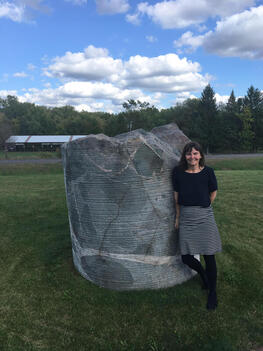 Deliriously happy on a road trip, beside a huge rock core sample somewhere between Montreal and Victoria. I was raised with rock samples of normal sizes, the length of a forearm, so this was a Gulliver experience. The grooves would be evidence of poor cutting on smaller specimens at least. Deliriously happy on a road trip, beside a huge rock core sample somewhere between Montreal and Victoria. I was raised with rock samples of normal sizes, the length of a forearm, so this was a Gulliver experience. The grooves would be evidence of poor cutting on smaller specimens at least. Every so often people will refer to exercises that strengthen the core. “What is this ‘core’?” I ask – my little joke, since surely chaos is gurgling out of my collar or fluttering like car lot flags from my cuffs. My daughter and I were recently talking about a very wealthy friend, asking the usual How do they do it? We decided that the friend focuses on the big pieces and doesn’t get lost in minutiae’s fuzz. They follow the 80/20 rule: put 20% of effort into 80% of a task, and then move on, ignoring the task’s final 20%, which will take 80% effort. I told her about the two main ways that people give directions: if you ask someone how to get to The Churchill, the bar I was at last night that I eventually found my way out of but without my backpack*, most people – let’s say 80% -- will describe the path to walk or drive there, from an eye-level perspective. But a few others mentally rise above the streets and look down, giving directions from that vantage point on the surrounding landscape. Our wealthy friends would be in that camp. A few weeks ago, I decided to work on my core, a big piece that I’ve always ignored in favour of such things as running the tip of a finger along the rises and troughs of the other hand’s knuckles and committing again to mastering flipping a ruble from one dip to the next. One goal of working on my core would be to see my abs. As I get older, I grow more interested, from curiosity and gratitude, in my innards, so close and yet unseen, as if just beyond a horizon. At some point, human skin must have evolved to be opaque, perhaps to foil enemies aiming weapons, or perhaps more happily, to reduce distractions during discussions towards creating a civil society. My boyfriend has introduced me to the gym as a place one goes regularly and with a plan, like a recipe. I now do sit-ups on an inclined bench (against gravity, despite my personal inclination) – three sets of twelve reps, sometimes clutching a 5-pound barbell plate to my chest. I also complete sets on a contraption that is essentially the arms of a chair set in space at shoulder level; I rest my forearms on the rests and dangle like a child, then raise my knees to my chest with resolve. But what is core? Urban downtowns have a core. A degree program has core curriculum. My son Tom tells me some Marxian international political theorists refer to the west as core and the rest of the world as periphery. My civil engineer father’s office was strewn with core samples – cylinders of granite and sandstone I loved to hold. Cut by diamond-toothed drill bits, they were smooth, had a comforting baby-size heft, and retained the cool of the secret of where they were from. They were mysterious, not meant to be seen, and weirdly regal – within-ness bearing exposure, offering no more than they had to. A first use of the word core was applied to the centre of an apple, but the origin of the word is uncertain, ironically wobbly. Etymonline.com, a website that holds my heart, says the word is “probably” from the Latin cor, meaning heart. The Mayo Clinic explains with the subtlety of a butchery cuts map that “your core is the central part of your body. It includes your pelvis, lower back, hips and stomach. The stomach muscles sometimes are called abs.” So our core is a cross-section, not a through-line. I think of it now as a protector of our centre of gravity. Women cannot see their abs, my boyfriend explains, unless they burn off all their fat. How does he know this? A website called bestwoman.com explains that “the lower your body fat, the thinner your skin will appear, and the more your abdominal muscles will show through.” I don’t want to burn off all my fat. I love my fat in the creamy way I love avocados. I don’t want to develop a thin skin alongside physical strength. Weeks into my exercises, my stomach is tense, like armour a few grades above tinfoil. I’m actually finding it an interruption. I miss pushing my finger into my belly and feeling its give. I realize this has been a habit, a kind of checking in. On the other hand, last night, when I reached in bed to turn out the light, my body swiveled with great ease, as if the world’s socket for it had been greased. *When I called the bar the next day, they had indeed found my backpack. They asked me to identify its contents as they peered inside. "There is a small journal with a red cover, and two poetry collections, one by Galway Kinnel and the other by W.S. Merwin," I said. "What else?" the woman asked.
0 Comments
Leave a Reply. |
AuthorSara Cassidy posts short creative non-fiction pieces on Instagram @sarascassidy The longer ones are in full here. Archives
January 2024
Categories |
 RSS Feed
RSS Feed
